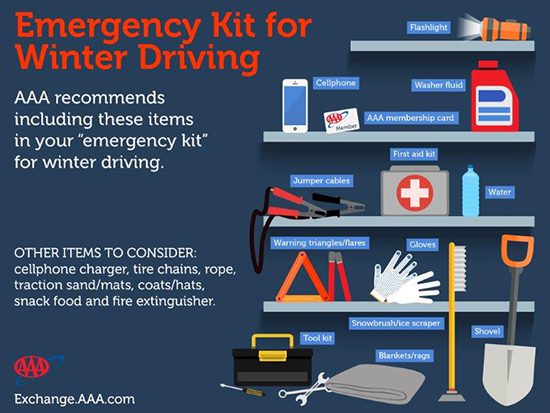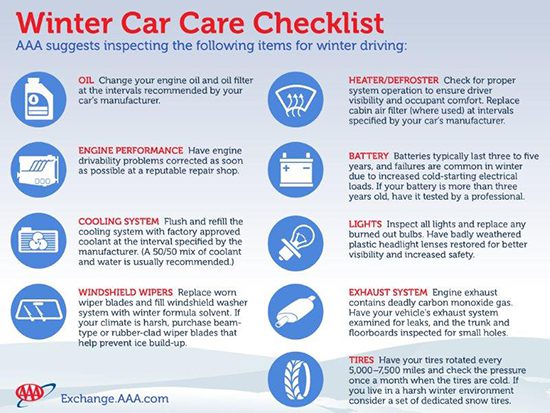Take basic safety precautions to reduce dangers of winter travel
PORTLAND, Ore. – Oh, the weather is expected to be frightful this weekend with snow forecast for the Portland area and much of the Willamette Valley. AAA Oregon/Idaho urges drivers to be be ready for snow and ice during winter driving conditions. “Make sure you and your car are ready for snow and icy driving conditions. Prepare your vehicle for colder temperatures and hazardous road conditions, and take it easy behind the wheel,” says AAA Oregon/Idaho Public Affairs Director Marie Dodds.
Whenever Mother Nature brings freezing temperatures and precipitation, the number of calls to AAA Oregon/Idaho for roadside assistance can spike. The most common problems in cold weather are dead batteries, frozen locks and vehicle extrications. “During a snow event, we can easily receive two to four times the normal number of calls,” adds Dodds.
Before heading out in Oregon, visit TripCheck.com or call 511 for the latest road conditions and incident information, especially if you are driving over mountain passes.
AAA has tips to help you face winter driving conditions:
Car Preparation
- Make sure your vehicle is ready with proper traction in snowy and icy conditions. Snow tires and/or chains are often the best options in snowy conditions. With light or moderate snowfall, a set of all-season tires may suffice. Remember the amount of traction that exists between the tires and roadway surface determine how well your vehicle accelerates, turns and stops.
- All-wheel-drive and four-wheel-drive systems can improve traction in many situations; however, they don’t provide significantly greater traction on ice.
- Have your battery and electrical system tested to make sure it’s ready for the snow and ice. Most batteries have a life span of about three years and may not turn over in cold weather. AAA can check your battery before you hit the road. Schedule a time for a AAA battery technician to come to your vehicle and test your battery, starter and alternator. We’ll even deliver a new battery, install it and take away your old one.
- Check all fluid levels, including anti-freeze, transmission fluid, brake fluid and engine oil.
- Make sure all lights operate properly.
- Inspect tires and brakes. Tires with less than 4/32” of tread will have reduced traction in wet and snowy conditions. Put a quarter in the tread. If you can see the top of George Washington’s head, it’s time to start thinking about replacing the tire. In addition, make sure tires are properly inflated, and check for signs of uneven wear.
- Check windshield wipers and washer fluid levels.
- Try to keep the fuel tank at least half full at all times in case you get stuck or encounter long traffic delays. Make sure your EV is fully charged before setting out in cold conditions.
Winter Driving Kit
- Keep an emergency kit in your car with tire chains, abrasive material such as sand or kitty litter, small shovel, flashlight with extra batteries, ice scraper, rags or paper towels, flares or other warning devices, booster cables and a first aid kit.
- Bring blankets, jackets, hats and gloves for you and your passengers.
- Pack water and snacks, such as energy bars, and bring pet food if you’re traveling with four-legged friends.
- Charge your mobile phone before you hit the road.

Drive Smart
- Slow down on snow and ice covered roads. Watch the traffic ahead and slow down immediately at the sight of brake lights or skidding vehicles.
- Leave plenty of distance between you and the car in front of you. Allow at least three times more space than usual.
- Make gentle stops and starts to prevent skids; don’t brake or accelerate quickly.
- Don’t brake and turn at the same time as this can make your tires lose traction.
- Steer out of a skid. If your vehicle begins to skid, take your foot off the brake and the accelerator and look where you want to go. Gently steer the car in that direction, keeping both hands on the steering wheel.
- Avoid unnecessary lane changes as this increases the chances of hitting a patch of ice between lanes.
- Don’t power up hills because this may only result in spinning your wheels. At the same time, don’t stop while traveling uphill as it can be difficult to get going again.
- Know what type of braking system you have and how to apply brakes properly (for example, don’t pump anti-lock brakes. Instead, firmly press the brake pedal. Downshift to a lower gear to reduce speed.
Use Common Sense
- Dress according to weather conditions and bring an extra coat, gloves and change of clothes in case you get wet putting on chains or changing a tire.
- Let family members or friends know your travel plans, including destination, route, and expected time of arrival so they can alert authorities if you don’t make it to your destination.
- Don’t blindly follow your GPS. If it directs you to a road that doesn’t look maintained or well-travelled, turn around!
- If you do get stuck, stay with your vehicle. It’s much easier for authorities to find you there.

Learn more about Winter Prep and get Ready for Snow and Ice
AAA news releases, high resolution images, broadcast-quality video, fact sheets and podcasts are available on the AAA NewsRoom at NewsRoom.AAA.com.
For more info go www.AAA.com. AAA Oregon/Idaho provides more than 800,000 members with travel, insurance, financial and automotive-related services, and is an affiliate of AAA National, serving more than 59 million members in North America.

